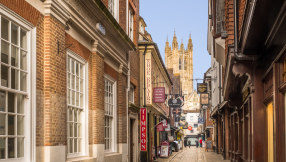
The warden of a historic church repeatedly targeted by lead thieves has expressed frustration with planning regulators who want stolen roofs to be replaced with the same material, despite the risk of another theft.
Cristina Fearon is warden at St Peter's, Stourton, in Staffordshire, a Grade I listed church dating back to 1290. It discovered last week that its lead roof had been stolen for the second time, putting at risk six weddings booked in for the remainder of the summer.
Work to repair the roof after it was stolen the first time in 2012 was only completed last year at a cost of £160,000, a sum that took the congregation four years to raise, The Telegraph reports.
She told the newspaper that after that theft, she had pleaded with planning regulators for a cheaper alternative material to be used instead of lead, a lucrative commodity for metal thieves.
However, she says the church was told that the planning rules meant the replacement metal had to be lead.
She told The Telegraph that the need for a like-for-like replacement was "putting churches at risk".
"There has to be a bit of realism about this," Mrs Fearon said.
Changes to church buildings have to receive planning permission from the local Diocesan Advisory Committee (DAC) but if the building is listed, it also requires the approval of the local council planning department.
The Church of England's Church Buildings Council (CBC) recommends lead as the "most appropriate" material for roofs but Secretary Becky Clark said that "there is absolutely no presumption that lead must always be replaced with lead".
"Lead theft is a persistent problem for churches and the Church of England has been in the forefront of efforts to combat it including working with the police to secure a change in the law to impose tougher sentences for thieves," she told the newspaper.
Current CBC guidance suggests terne-coated stainless steel as the best alternative to lead. However, it also states that this should ideally be used on "low-lying roofs" rather than those in prominent positions, and that in buildings with greater "architectural sensitivity", the replacement material should match that of the stolen roof.
"For a great many roofing applications lead is the most appropriate roofing material for appearance, performance, ease of installation and lifespan. It is part of the heritage of our built environment. However, replacing like with like is not always realistic after lead has been stolen, in particular where there have been multiple thefts," the guidance reads.
It continues: "The material that is most often used to replace a traditional church roof after a theft when the continued use of lead is not realistic is ternecoated stainless steel on account of its appearance and performance on traditional buildings. It has received broad support around the country, weathers well, and can have a lifetime of more than 50 years.
"The Church Buildings Council considers that this is the material most likely to be substituted for lead for roofing when replacement of lead is not viable. Careful detailing of stainless steel is required to maintain the character of the building.
"There are concerns about its appearance on prominent roofs, but these are less relevant where its use is proposed for low-lying roofs, such as aisles and extensions, and when the roof is not readily visible from ground level, for example when it is behind a parapet.
"The greater the architectural sensitivity of a building the more important it is that any alternative replacement material matches that of the stolen roof."













